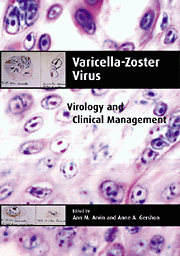Book contents
- Frontmatter
- Contents
- List of contributors
- Preface
- Introduction
- Part I History
- Part II Molecular Biology and Pathogenesis
- 2 Molecular evolution of alphaherpesviruses
- 3 DNA replication
- 4 Viral proteins
- 5 Pathogenesis of primary infection
- 6 Pathogenesis of latency and reactivation
- 7 Host response to primary infection
- 8 Host response during latency and reactivation
- 9 Animal models of infection
- Part III Epidemiology and Clinical Manifestations
- Part IV Laboratory Diagnosis
- Part V Treatment and Prevention
- Index
- Plate section
8 - Host response during latency and reactivation
from Part II - Molecular Biology and Pathogenesis
Published online by Cambridge University Press: 02 March 2010
- Frontmatter
- Contents
- List of contributors
- Preface
- Introduction
- Part I History
- Part II Molecular Biology and Pathogenesis
- 2 Molecular evolution of alphaherpesviruses
- 3 DNA replication
- 4 Viral proteins
- 5 Pathogenesis of primary infection
- 6 Pathogenesis of latency and reactivation
- 7 Host response to primary infection
- 8 Host response during latency and reactivation
- 9 Animal models of infection
- Part III Epidemiology and Clinical Manifestations
- Part IV Laboratory Diagnosis
- Part V Treatment and Prevention
- Index
- Plate section
Summary
Studies of immunity to varicella-zoster virus (VZV) after primary infections are predicated largely on the view that cell-mediated immune responses contribute to the prevention of reactivation from latency. The evidence supporting this comes from the increased frequency of zoster following immunosuppressive treatments, particularly total lymphoid irradiation and cancer chemotherapy. The principal difficulty in examining immunity to VZV is the lack of an animal model supporting primary disease and, later, emergence of the virus from latency. Animal models of cell-mediated immunity to other viruses and to HSV and CMV in particular, have recently advanced enormously. These animal data are summarized first in the following paragraphs, so as to provide a background against which the more limited human studies of VZV-specific immunity can be placed.
Immunity to viruses
Once a primary infection has been controlled, the importance of antibody for neutralizing viruses before they infect susceptible cells remains unchallenged. The memory cells, which maintain immunity to viruses including VZV, are selected from lymphocytes that participated first in the primary immune response – so the course and kinetics of primary immunity are key to understanding the host response during latency. The past few years have seen advances in our understanding of the interactions between viruses and the cells they infect and of the interactions between antigen-presenting cells and the CD4 and CD8 T cells that respond.
Lytic viruses such as VZV destroy cells whose debris is phagocytosed mostly by neutrophils, macrophages and dendritic cells. When the phagocytic vacuoles and lysosomes fuse the lysosomal proteases activate and cleave off an invariant chain from class II major histocompatibility (MHC) molecules, preparing them for antigen binding.
- Type
- Chapter
- Information
- Varicella-Zoster VirusVirology and Clinical Management, pp. 157 - 168Publisher: Cambridge University PressPrint publication year: 2000

